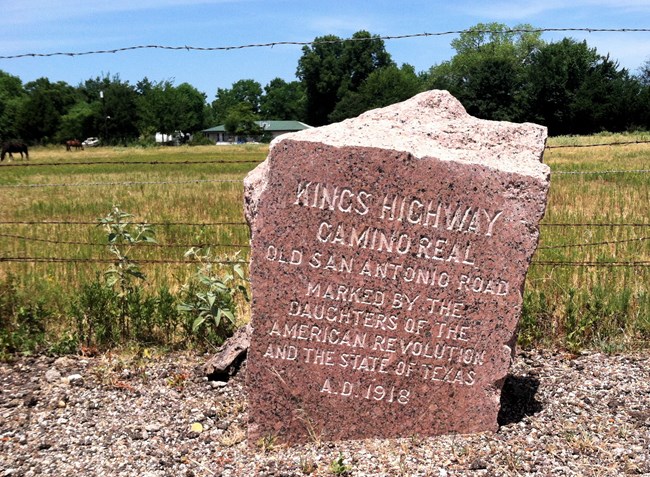Last updated: September 29, 2023
Article
History and Memory on El Camino Real de los Tejas
Traversed by horse, wagon, and foot for most of its history, El Camino Real de los Tejas changed forever with the introduction of the automobile in the early twentieth century. Many parts of the camino were paved and incorporated into state transportation networks. Thankfully, this shift to a modern highway system hasn’t erased the camino’s history, and the current highway system makes it possible to drive the historic trail from southwestern Texas into Louisiana.

Image/ Jpo tx113, CC BY-SA 4.0 <https://creativecommons.org/licenses/by-sa/4.0>, via Wikimedia Commons
Historical Markers
Beginning in 1918, the Daughters of the American Revolution sought to commemorate the route with road markers. These roadside markers laid the groundwork for historical designations, both of the road itself and of buildings and physical remnants along it. By 1929, the state of Texas had recognized the historical significance of the route, naming it one of the state’s historic trails and entrusting the state highway department with its preservation and maintenance. In 2004, an act of Congress designated El Camino Real de Los Tejas as a national historic trail. Today’s drivers can see modern National Park Service signage as well as older markers—such as #84 in San Pedro Park in San Antonio, which hosted a dedication ceremony for the project.
Preservation of Buildings and Infrastructure
Historical traces of a variety of cultures abound along El Camino Real de los Tejas. Those looking to learn more about Texas’ Indigenous history can visit Caddo Mounds State Historic Site. The site is renowned for its impressive earthworks, which connect it to the larger history of Mound Builder culture.
Early European settlements are still standing in some places. Although the presidio of La Bahía was built in 1749, part of it remains in use today. The military outposts in Goliad offer various options for learning about Spanish colonial administration and early interactions with French explorers. For the faithful, mass is held every Sunday in Our Lady of Loreto Chapel, and history buffs can rent out a preserved room in the Quarters that once housed military commanders and diocesan priests.
The city of San Antonio offers ample opportunities to interact with the Spanish colonial past. La Villita was a site of heavy fighting during the Texas Revolution, as was, of course, the Alamo. San Antonio’s Military Plaza, built as the town’s focal point, boasts nearby attractions like the Spanish Governor’s Palace and San Fernando Cathedral.
Other locations, such as McKinney Falls, are sites of early Anglo-American settlement in Texas. Though the original buildings were not preserved, the ruins at McKinney Falls offer some insight into how, when, and why buildings were constructed for the farmers and ranchers who moved into the area in the nineteenth century. The Durst-Taylor House in Nacogdoches includes a historic garden growing some of the same plants that thrived on the property in the early nineteenth century, and even presses sugarcane into syrup at the annual Old-Fashioned Sweet Tooth Sugarcane event.
San Antonio’s outsized role in Texas history can sometimes overshadow other places along El Camino Real de los Tejas. However, Indigenous, Spanish, Mexican, Anglo-American, and, later, German heritage are all represented on the trail corridor. Human populations have struggled, prospered, grown, shrunk, fought, and allied with one another along the trail for millennia. Pulling back the different layers, asking new questions, and presenting the past in new ways continues to deepen our knowledge of this shared history.
Living in the Past
Places such as the Alamo in San Antonio and Los Adaes in Natchitoches sometimes offer reenactments giving viewers a more visceral experience of past. In these performances, actors appear in clothing from the period, practice traditional trades, and offer insights into what life was like for Texans of all stripes in the eighteenth and nineteenth centuries.
Written sources provide another way to access the past, for historians and laymen alike. The Briscoe Center at the University of Texas in Austin holds a vast collection of documents related to Spanish, Mexican, and American Texas. These documents offer glimpses into the region’s administration and commerce as well as the lives of administrators and common citizens. Such letters, receipts, inventories, and legal documents produced by past Texans form the backbone of modern historical scholarship.
Oral histories are also extremely valuable for those seeking to reconstruct the past, playing an essential role in preserving and transmitting cultural knowledge that was never expressly recorded in writing. San Antonio Missions National Historic Park has an oral history series that is open to the public, both in person and online. These interviews, featuring stories handed down within families, were conducted with the descendants of Indigenous peoples who lived in the missions in the eighteenth century. Oral history interviews like these help us bring the unwritten past into the digital present.
Throughout its history, the Camino Real de los Tejas to act has been a means of connection. It continues to be today, not only connecting cultures to one another but connecting the present to the historical past. Though cars can cross the 556 miles from Laredo to Natchitoches in about nine hours, they do so on the same route that people, horses, and wagons have traversed for centuries.
(Special thanks to UNM PhD candidate Meghann Chavez for compiling this information)
